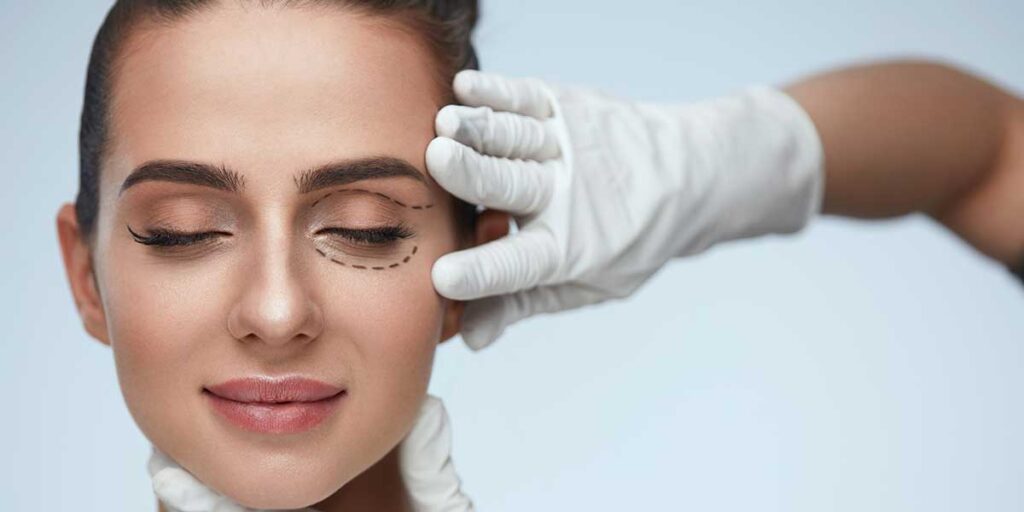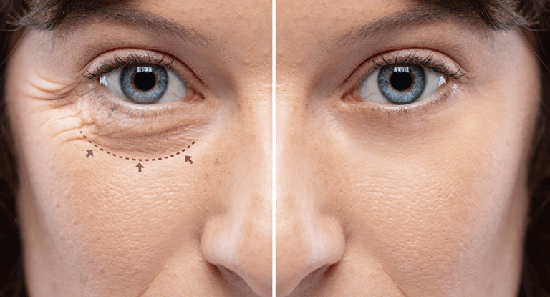Blepharoplasty can be described as a procedure performed on the eyelids for beautification. It is committed to eliminating excessive facial skin of the eyelids’ upper part and reducing bags on those lower eyelids, also known as the eyelift.
Why Is Blepharoplasty Done?
As the skin age gradually loses its elasticity. Losing elasticity and gravity’s constant pull can cause excessive skin accumulation on the upper and lower eyelids. The thick layer of skin covering the lower eyelids causes wrinkles. Another fold of skin can be visible above the eyelashes on the upper lids and block the sight line.
The fact that it shields the eyeball from the skull may cause bulges on the eyelids of the lower and upper. The thin skin layer that holds this fat in its place becomes less supple with age, allowing it to slip to the lids and cause the result of an open hernia.

The procedure is generally done for cosmetic reasons. It’s also a great way to enhance vision for ageing people whose eyelids are sagging and block their vision. The procedure is usually done as a part of other procedures like cosmetic surgery using lasers, filler injections, or forehead lifts. Lifting the eyes is the best solution to dark circles under the eyelids, deep circles around the eyes, crow’s feet, and other facial wrinkles.
Who Will Benefit from Blepharoplasty?
The ideal candidates for an eyelift are healthy and can define what they’d like to achieve. The majority of people are 35 years old or above. However, when droopy or baggy eyelids are a common trait as a part of your family history, you can opt to have the procedure carried out earlier. Cosmetic surgery for your eyelids can enhance your appearance and increase confidence. However, it will create the ideal impression or alter the shape of your face. If you are considering having surgery, consider your objectives and discuss these together with your doctor, and proceed for surgery.
Process Before Surgery:
The process of preparing for surgery on the eyelids is very easy. In the beginning, you’ll require to first consult with your plastic surgeon to be able to discuss the issues you have and goals for outcomes for your eyes. Inquiring with your doctor about their experience in this procedure is also essential. Before you can undergo this procedure, the surgeon needs to conduct several tests.
Physical examinations are conducted to assess and examine your eyes. Tests for tears and vision are also carried out. The doctor will also take pictures of your eyes to assist the doctor during the procedure. It is essential to inform your doctor of the medications you’re taking. You will likely be advised to stop taking any medication that increases bleeding risk, such as Aspirin, Ibuprofen or warfarin. Those who smoke must quit smoking for a few weeks before having a blepharoplasty surgery.
Blepharoplasty Procedure:
The typical duration for an eyelift is two to three hours if both the lower and upper eyelids are completed in conjunction. The doctor may use local anesthesia (medication injectable in the eyes) and oral sedation. The surgeon will concentrate first on the upper lids. Using surgical incisions along natural creases, the surgeon removes excess skin and tightens the underlying tissues, along with removing any excess fat.

Thus the bulges are treated. Special sutures are applied so that no marks of sutures remain after healing. These sutures are placed on the upper lids and kept for 3-6 days. Lower lids could require sutures, depending on the procedure used.
The lower eyelids can be done by employing one of several techniques. One approach is for the surgeon cuts into the lower eyelids of the patient to reduce the fat. The amount won’t be noticeable. The surgeon can smooth skin lines with lasers like CO2 or Erbium laser. Another alternative is to cut along the edge of the eyelash. The surgeon could cut off excessive skin tissue, muscles, and fat by cutting the part. The scars of surgical incisions usually fade away within 3 to months.
After the Operation:
The doctor can apply ointment to your eyes to make sure they’re well-hydrated and cover them with cold compresses for your time in the recovery area. Following the procedure, you may have swelling and bruising of the operated area. Usually, the healing process is fast, and typically patients are comfortable. Scrapes and swelling have significantly decreased in just ten days. The patient can resume their normal routine and be out with ease. Your doctor will give you specific guidelines to take good care of yourself.
Benefits of Blepharoplasty
Given below are some of the benefits you will get after your surgery. It shows how beautiful your eyes will be after the surgery that makes you look more confident as well.
- Restoring a Younger Shape Above the Eyes
- Looking Like Agile and Alert
- A Boost of Confidence
- An Improved Field of Vision (in case of severe hooding of eyelids)
- Great Improvements with Minor Scarring
- Gives Long-Term Results

The procedure can reduce the puffiness of the lower eyelid bags and dark circles around the eyes. Also, you can go home on the same day following the procedure.
Which Patients are not suitable for Blepharoplasty?
The most suitable persons for Blepharoplasty are those typically 30 years of age or more who are healthy and have no other eye problems. Inform your eye doctor that you suffer from any of the following eye conditions:
- Eye conditions such as dry eye, glaucoma, or a detached retina
- Thyroid conditions such as Graves’ disease and thyroid hyper- or hypoactivity
- The heart, high blood pressure, or other circulatory conditions
- Diabetes
Be honest about the expectations you set for Blepharoplasty. Eyelid surgery can improve your appearance and increase your confidence. But don’t think the procedure will drastically change your look. Many people have eyes that aren’t completely aligned or appear different in size. Asymmetrical features are common in the initial phases of growth. Blepharoplasty does not change the facial shape. It is essential to understand your face’s structure before undergoing surgery. Consider your goals carefully, as well as discuss them with the surgeon.
Ancillary Procedures Along with Blepharoplasty:

You may want to inquire with your surgeon about other procedures that could enhance cosmetic surgery results for the eyelids. Sometimes, a blepharoplasty procedure is performed alongside another to boost the effects. Those with prominent, sagging eyebrows may opt for an eyebrow lift. Some may opt for an entire facelift to fix other issues simultaneously. The ideal scenario is for eyelid surgery to be a one-time operation. However, it is possible to require subsequent surgeries if you enjoy the results or if your eyes don’t heal correctly initially.
How Long does the Procedure Last?
The results of blepharoplasty last for a long duration. Lower eyelid surgery is not often replaced. The upper eyelid surgery may last between five and seven years, or even the remainder of one’s life, based on the facial structure and particulars of the procedure. After this process, the patient will get a beautiful result. Don’t be worried about their recovery process. The patient will get well soon. If you’re worried about significant levels of skin or sagginess in your eyes, speak to an expert in dermatology or your surgeon about that. The procedure treats the age-related signs that commonly occur within your sight. Follow all the instructions given by your surgeon.
